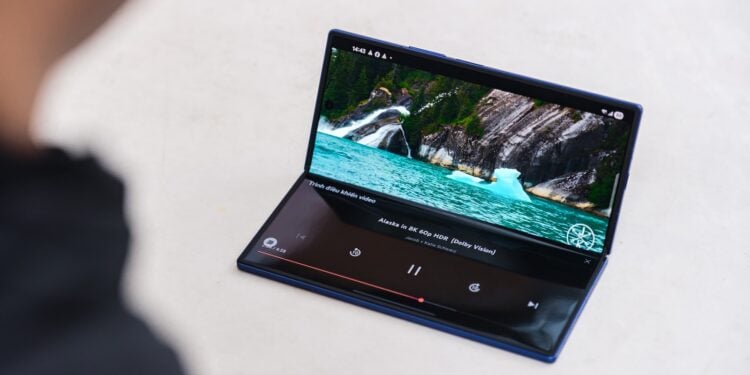The iPhone Fold is no longer just a rumor. Increasing evidence suggests that Apple will unveil its first foldable iPhone in the fall of 2026. While other manufacturers have been gaining experience with this technology for years, Apple has waited – and that could prove to be an advantage. The market for foldable smartphones is currently experiencing a phase where technology, demand, and user interest are truly converging for the first time.
When Samsung unveiled its first foldable smartphone in 2019, the enthusiasm was huge – but it didn't last long. The devices were expensive, fragile, and technically underdeveloped. The idea was fascinating, but the implementation wasn't yet ready for mass production. Foldable smartphones remained a niche product for years.
That's changing now. New models are more robust, lighter, and better designed. The software adapts flexibly, the displays last significantly longer, and everyday usability has noticeably improved. According to an analysis by Counterpoint Research, 2025 could be the first real boom year for the market. Sales of foldable devices are expected to grow by around 68 percent this year, particularly in the US. This creates precisely the environment in which the iPhone Fold is set to debut.
The perfect time for the iPhone Fold
Apple's entry into the market is late, but probably at just the right time. When the iPhone Fold is released in 2026, seven years will have passed since Samsung's first Galaxy Fold. While that might sound like a race to catch up, Apple is following its tried-and-tested strategy: preferring to wait until a technology is truly mature rather than releasing half-baked products.
The company has successfully used this tactic several times before – for example with the iPod, the iPad, and the Apple Watch. Apple was never the first, but often the one that made a product category suitable for the masses. The iPhone Fold is likely to be no different.
The current market offers the ideal opportunity. After years of testing and refinement, the technology has advanced to the point where foldable smartphones no longer require any technical compromises. Hinges last longer, displays are more durable, and the software makes efficient use of screen space. Manufacturers like Samsung, Motorola, and Google have experimented extensively – and largely eliminated the devices' biggest teething problems.
The new dynamics in the foldable smartphone market
According to Liz Lee, deputy director at Counterpoint Research, the market is on the verge of a decisive turning point. Her analysis states:
The US market for foldable smartphones is evolving from a novelty to a necessity.
Samsung will remain the market leader, but the competition is catching up – especially Motorola with its clamshell design and Google with its AI approach. With Apple's market entry in 2026, the market will broaden considerably, and foldable devices will firmly establish themselves in the premium segment.
This assessment aligns with recent market trends. Samsung is reporting strong sales figures for the Galaxy Z Fold 7 and emphasizes that the seventh generation "offers an experience unlike any other device." This demonstrates how much the technology has improved in recent years. Consumers who were previously skeptical are now showing significantly more interest.
This puts Apple in a favorable position. While other manufacturers have already paved the way, Apple can build on a mature foundation. When the iPhone Fold launches in 2026, it will reach an audience already familiar with the concept of foldable smartphones – but waiting for Apple's signature implementation.
Apple as a possible turning point
The announcement of the iPhone Fold is likely to shake up the entire market. Apple has the ability to pick up on existing trends and bring them into the mainstream. Once the foldable iPhone is unveiled, it will probably serve as a benchmark for design, software integration, and everyday usability.
Apple's entry into the market could also force manufacturers like Samsung and Google to innovate in order to maintain their position in the premium segment. At the same time, competition is expected to drive down the prices of foldable smartphones in the long run. This could make the devices attractive to a broader range of buyers – another factor that supports Apple's late but astute timing.
Apple's perfect timing for the iPhone Fold
The iPhone Fold is late to the party, but it's arrived at the right time. After years in which foldable smartphones were more of a technological gimmick, the market has now stabilized. The devices are robust, suitable for everyday use, and technically mature.
When Apple launches the iPhone Fold in fall 2026, the company will enter an environment ripe for the next step. The market is growing, the technology is compelling, and demand is rising. It looks like Apple is entering the market just when foldable smartphones are no longer just a novelty—but a genuine alternative to traditional models. The timing couldn't be better. (Image: Shutterstock / tinhkhuong)
- Apple is now part of the Game Awards advisory board.
- Nvidia reaches $5 trillion – a record in the tech world
- Bank of America raises price target for Apple to $320
- Apple will spend more money on lobbying in Brussels in 2025.
- Apple presents AI dataset for improved image processing
- Apple makes serious allegations against former engineer and Oppo
- Apple releases iOS 26.1 RC – final version is ready
- iPhone Air battery test: A whole day despite small battery
- Apple continues to grow: iPhone boom drives market value to 4 trillion
- Apple's service revenue is expected to reach $100 billion for the first time
- Threads introduces ghost posts – posts that disappear
- WhatsApp introduces new storage management for individual chats
- EU criticizes Meta and TikTok for lack of child protection
- Apple remains strong: JP Morgan now sees price target at $290
- Apple held an exclusive Vision Pro event for developers
- Swift SDK: Android support marks a turning point for Apple
- Apple significantly expands AirPods production in India
- iOS 26.1 introduces stable photo backups for third-party apps
- Apple in leak trial: Fanboy seeks out-of-court solution
- M5 MacBook Pro teardown: top performance, repair flop
- Apple surprises with strong growth in Mac sales
- Apple accelerates US production for its own AI servers
- Vimeo expands 3D support for Apple Vision Pro
- Is Apple withdrawing app tracking protection due to EU pressure?
- Future iPhone could have greater NFC range





